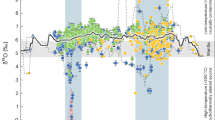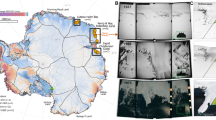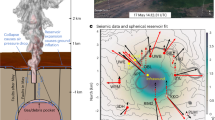Abstract
WHETHER or not aseismic ridges and seamounts on the ocean floor are due to stationary hot spots1–7 or some other process, one may ask what happens when an aseismic ridge is forced into a subduction zone. Here I consider one aspect of the problem, namely whether or not the plan view of island arcs and their associated trenches has been influenced by aseismic ridges being subducted. Island arc type subduction occurs primarily in the western Pacific and the Indian Oceans. As indicated in Fig. 1, there are a small number of aseismic ridges in the vicinity of the north and western Pacific and Indian trenches. The bathymetric charts recently published by Chase et al.8 were used to obtain the general outlines of the Pacific aseismic ridges. The two most massive Pacific ridges, the Emperor and Caroline, intersect the trench system near prominent cusps, where one arc gives way to the next. In addition, the Marcus–Necker ridge intersects the northern edge of the arcuate portion of the Marianas trench; the Gulf of Alaska seamounts, presumably generated by the Juan de Fuca and/or its neighbour, the Yellowstone plume5–7, intersect the Aleutians only slightly west of the cuspate eastern end of the Aleutian arc. In the Indian Ocean, the two principal cusps in the boundary between Asian and Indo–Australian plates are now intra-continental. It may reasonably be supposed, from its arcuate character and continuity with the Indonesian arc, that the Himalayan arc replicates the shape of an extinct island arc system lying in the Tethyan Ocean, that lay between India and central Asia until it was closed by subduction in later Tertiary times. Whether or not the Himalayan arc preserves the shape of an old island arc, the Indian Ocean's two prominent aseismic ridges9 extend, with comparatively minor extrapolation, into the two major cusps of the Himalayan tectonic arc.
This is a preview of subscription content, access via your institution
Access options
Subscribe to this journal
Receive 51 print issues and online access
$199.00 per year
only $3.90 per issue
Buy this article
- Purchase on Springer Link
- Instant access to full article PDF
Prices may be subject to local taxes which are calculated during checkout
Similar content being viewed by others
References
Wilson, J. T., Nature, 197, 536 (1963).
Wilson, J. T., Can. J. Phys., 41, 863 (1963).
Wilson, J. T., Nature, 198, 925 (1963).
Wilson, J. T., Phil. Trans. Roy. Soc. (Lond.), 258, 145 (1965).
Morgan, W. J., Nature, 230, 42 (1971).
Morgan, W. J., Bull. Amer. Assoc. Petrol. Geol., 56, 203 (1972).
Morgan, W. J., Mem. Geol. Soc. Amer. (in the press).
Chase, T. E., Menard, H. W., and Mammerickx, J., Inst. Marine Res. Tech. Rep. Ser. TR-17 (Geol. Data Center, Scripps Inst., 1971).
Vogt, P. R., and Conolly, J. R., Bull. Geol. Soc. Amer., 82, 2577 (1971).
Karig, D. E., Bull. Geol. Soc. Amer., 82, 323 (1971).
Karig, D. E., J. Geophys. Res., 75, 239 (1970).
Bracey, D. R., and Ogden, T. A., Bull. Geol. Soc. Amer., 83, 1509 (1972).
Vogt, P. R., Nature (in the press).
Le Pichon, X., J. Geophys. Res., 73, 3661 (1968).
Wellman, P., and McElhinney, M. W., Nature, 227, 595 (1970).
McKenzie, D. P., and Sclater, J. G., Geophys. J. Roy. Astron. Soc., 25, 437 (1971).
von der Borch, C., Sclater, J. G., Gartner, jun., S., Hekinian, R., Johnson, D. A., McGowian, B., Pimm, A., Thompson, R. W., and Veevers, J. J., Geotimes, 15 (June, 1972).
Palmason, G., Science Institute, Univ. of Iceland and National Energy Authority, Reykjavik, 239 (1970).
Bott, M. P. H., Browitt, C. W. A., and Stacey, A. P., Mar. Geophys. Res., 1, 328 (1971).
Malahoff, A., in The Earth's Crust and Upper Mantle, Geophys. Monograph, 13, AGU 364 (1969).
Ryall, A., and Bennett, D. L., J. Geophys. Res., 73, 4561 (1968).
Isacks, B., Oliver, J., and Sykes, L. R., J. Geophys. Res., 73, 5855 (1968).
Minear, J. W., and Toksöz, M. N., J. Geophys. Res., 75, 1397 (1970).
Lake, P., and George, J., Geol. Mag., 78, 149 (1931).
Lake, P., Geol. Mag., 68, 34 (1931).
Frank, F. C., Nature, 220, 363 (1968).
Author information
Authors and Affiliations
Rights and permissions
About this article
Cite this article
VOGT, P. Subduction and Aseismic Ridges. Nature 241, 189–191 (1973). https://doi.org/10.1038/241189a0
Received:
Published:
Issue Date:
DOI: https://doi.org/10.1038/241189a0
This article is cited by
-
The nature of the Pacific plate as subduction inputs to the northeastern Japan arc and its implication for subduction zone processes
Progress in Earth and Planetary Science (2023)
-
Ridge subduction, magmatism, and metallogenesis
Science China Earth Sciences (2020)
-
Myanmar-Andaman-Sumatra subduction margin revisited: Insights of arc-specific deformations
Journal of Earth Science (2017)
-
The role of ridges in the formation and longevity of flat slabs
Nature (2015)
-
Petrologic perspectives on tectonic evolution of a nascent basin (Okinawa Trough) behind Ryukyu Arc: A review
Acta Oceanologica Sinica (2014)
Comments
By submitting a comment you agree to abide by our Terms and Community Guidelines. If you find something abusive or that does not comply with our terms or guidelines please flag it as inappropriate.



